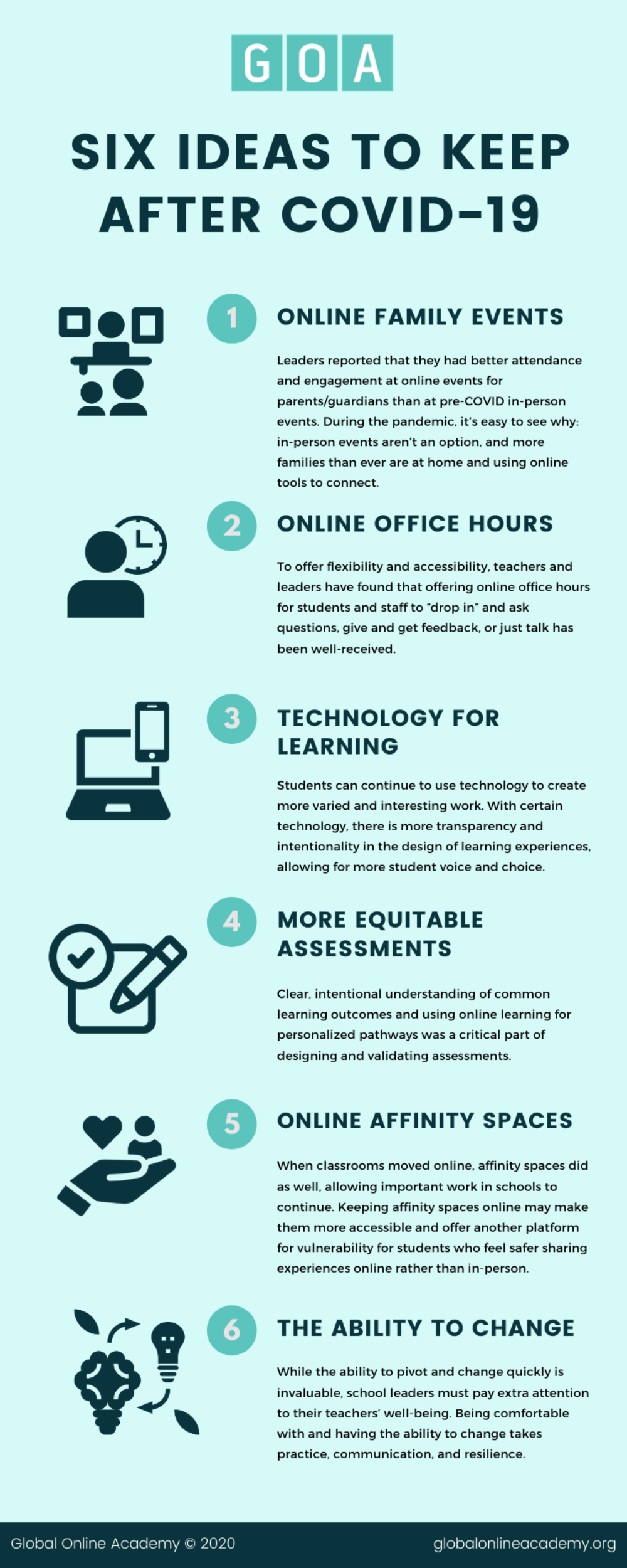Six Ideas School Leaders Want to Keep Post-COVID
There’s an enormous amount of change happening in education right now, change that has both required rapid response and has raised long-term questions about school. Leaders have had to balance supporting students, staff, and community members in the moment while looking ahead and strategizing for the future.
For the last two months, we’ve been working with nearly 150 district and school leaders in GOA’s program Leading Teachers Online. Each month, these leaders gather on Zoom to tackle pressing topics related to this challenging school year. A common concern has been how to both address urgent, immediate needs and to ensure our schools don’t just survive this year, but grow from it. To prepare for our most recent gathering, we asked school leaders to reflect on their first few weeks/months back at school and reflect in a strengths-based way: “What’s something you want to keep post-COVID?”
We found their responses inspiring and helpful. Below are six highlights, including some sample perspectives from participants.

1. Online Family Events
Leaders reported that they had better attendance and engagement at online events for parents/guardians than at pre-COVID in-person events. During a pandemic, it’s easy to see why: in-person events aren’t an option, and more families than ever are at home and using online tools to connect. In general, however, online events offer more flexibility and accessibility for families: it’s less of a time and childcare commitment to attend live, and it’s easy to make materials like recordings available for asynchronous use.
As one participant said, “No driving to school! Some of the technological interactions have now become normative. I foresee us continuing to use Zoom to bring together more people for events than might possibly attend in person.”
2. Online Office Hours
In the same spirit of offering flexibility and accessibility, teachers are offering more open office hours to students to connect in a more informal way. Leaders are imitating this work to support teachers, offering online office hours for teachers to “drop in” and ask questions, give and get feedback, or just talk. Teachers are carrying a heavier load than in normal years, and finding low-stakes, relational ways for them to gather and talk through challenges, share work, and maintain connections to colleagues has been a better strategy for leaders than trying to replicate more cumbersome, evaluative processes like classroom observations.
This participant put it well: “One thing I’d like to keep is the ability to check in with students more frequently by way of virtual one-on-ones, Jamboards, polls, etc. Also, online spaces for faculty to caucus together. Because the school day is so tight, offering times to caucus together is important. And, open Zoom room drop-ins. I can have fifty people stop into a Zoom with me if they want, but I can only fit a handful of people in my office.”
3. Technology for Learning
Leaders report that they have never seen teachers as invested and creative with technology as they are now. This is by necessity, of course, but some of the results are worth keeping: students using technology to create more varied and interesting work, more transparency and intentionality in the design of learning experiences, more student voice and choice, and use of synchronous and asynchronous modes to support flexible and personalized learning. Before COVID, many schools were pursuing initiatives that would help them improve the student learning experience and drive better outcomes, and they have realized that helping teachers build expertise with online spaces and digital tools is a way to achieve those goals.
Consider this school leader’s decision to upgrade technology in response to COVID: “This was an opportunity to abandon our very user-unfriendly LMS and develop Google sites for each course which are visually more appealing, more logically organized/easy to navigate, more convenient for linking to materials in Google Drive or online, and just generally richer, more engaging online learning spaces.”
4. More Equitable Assessments
The move online made urgent a question we’ve always recognized as important, “How do we know students are learning?” When students and teachers don’t share the same physical space and are working on different schedules or even in different time zones, traditional, time-based assessments like tests and quizzes often need to be rethought to reflect a more performance-based approach. Online spaces also offer an opportunity to create more personalized learning pathways for students. Clear, intentional understanding of common learning outcomes was a critical part of designing and validating assessments, and that collaborative work is something school leaders want to keep.
This participant’s response captures many of the ideas about assessment that we are hearing from leaders: “I appreciate that it's a timely opportunity to rethink and clarify what our learning outcomes are, and then to design backwards from there. The idea of what works best (especially as it pertains to assessments) in synchronous and asynchronous experiences is another helpful reframing to determine what is the best use of our time when we have our students in front of us (either in person or virtual).”
5. Online Affinity Spaces
Affinity spaces are intentional opportunities for students as well as teachers to engage, check-in, and share experiences in a safe setting. When classrooms moved online, affinity spaces did as well, allowing important work in schools to continue. Keeping affinity spaces online may make them more accessible and offer another platform for vulnerability for students who feel safer sharing experiences online rather than in-person. Online affinity spaces also open possibilities of having guest speakers or presenters from anywhere in the world as well as connections with students from other schools to broaden support and impact.
Consider how online spaces might support psychological safety: “Our students benefit when they have safe spaces to connect with others who have shared experiences and many of them found it safer to be online than in-person.”
6. The Ability to Change
Frequent change is and will be the norm for the foreseeable future. Many schools are currently transitioning from online to hybrid and in-person, and they need to stay flexible given the uncertainties of this moment. While the ability to pivot and change quickly is invaluable, school leaders must pay extra attention to their teachers’ wellbeing. Teachers often carry the heaviest burden in executing these changes, and schools must reinforce a culture where teachers are listened to and cared for during this time. Nimbleness in the face of change takes practice, communication, and resilience.
We loved this succinct insight from a school leader: “One thing I hope to keep is my ability to change and support my teachers through change.”
What do you want to see your community keep post-COVID? Connect with GOA on Twitter at @goalearning and let us know!
The GOA Design Lab offers strategic solutions and design support to school leaders planning for the future. Learn more about our services. For more free resources on online learning, visit our COVID-19 landing page.

